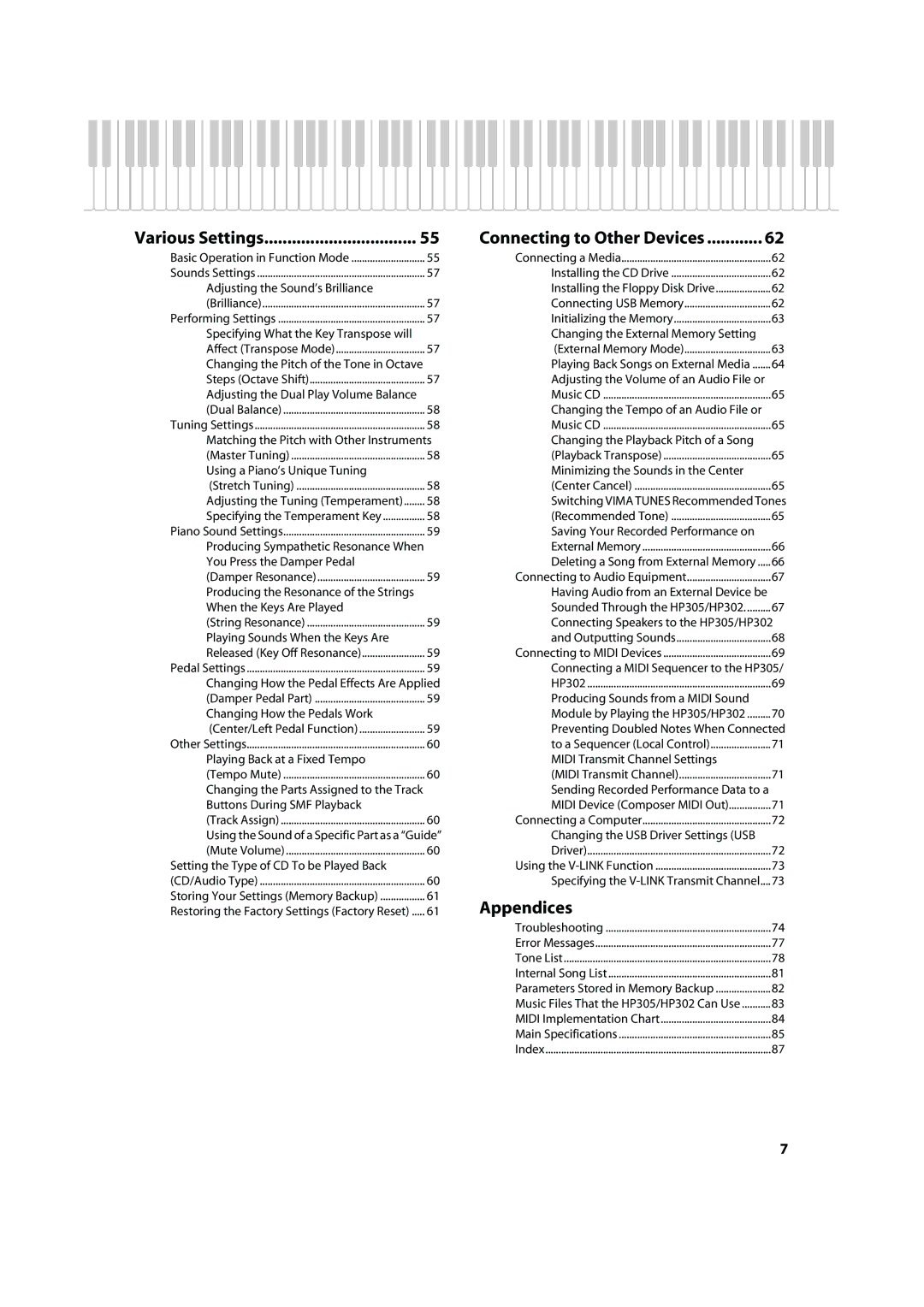
Various Settings | 55 | Connecting to Other Devices | 62 |
Basic Operation in Function Mode | 55 | Connecting a Media | 62 |
Sounds Settings | 57 | Installing the CD Drive | 62 |
Adjusting the Sound’s Brilliance |
| Installing the Floppy Disk Drive | 62 |
(Brilliance) | 57 | Connecting USB Memory | 62 |
Performing Settings | 57 | Initializing the Memory | 63 |
Specifying What the Key Transpose will |
| Changing the External Memory Setting |
|
Affect (Transpose Mode) | 57 | (External Memory Mode) | 63 |
Changing the Pitch of the Tone in Octave | Playing Back Songs on External Media | 64 | |
Steps (Octave Shift) | 57 | Adjusting the Volume of an Audio File or | |
Adjusting the Dual Play Volume Balance |
| Music CD | 65 |
(Dual Balance) | 58 | Changing the Tempo of an Audio File or |
|
Tuning Settings | 58 | Music CD | 65 |
Matching the Pitch with Other Instruments | Changing the Playback Pitch of a Song |
| |
(Master Tuning) | 58 | (Playback Transpose) | 65 |
Using a Piano’s Unique Tuning |
| Minimizing the Sounds in the Center |
|
(Stretch Tuning) | 58 | (Center Cancel) | 65 |
Adjusting the Tuning (Temperament) | 58 | Switching VIMA TUNES Recommended Tones | |
Specifying the Temperament Key | 58 | (Recommended Tone) | 65 |
Piano Sound Settings | 59 | Saving Your Recorded Performance on |
|
Producing Sympathetic Resonance When | External Memory | 66 | |
You Press the Damper Pedal |
| Deleting a Song from External Memory | 66 |
(Damper Resonance) | 59 | Connecting to Audio Equipment | 67 |
Producing the Resonance of the Strings |
| Having Audio from an External Device be | |
When the Keys Are Played |
| Sounded Through the HP305/HP302 | 67 |
(String Resonance) | 59 | Connecting Speakers to the HP305/HP302 | |
Playing Sounds When the Keys Are |
| and Outputting Sounds | 68 |
Released (Key Off Resonance) | 59 | Connecting to MIDI Devices | 69 |
Pedal Settings | 59 | Connecting a MIDI Sequencer to the HP305/ | |
Changing How the Pedal Effects Are Applied | HP302 | 69 | |
(Damper Pedal Part) | 59 | Producing Sounds from a MIDI Sound |
|
Changing How the Pedals Work |
| Module by Playing the HP305/HP302 | 70 |
(Center/Left Pedal Function) | 59 | Preventing Doubled Notes When Connected | |
Other Settings | 60 | to a Sequencer (Local Control) | 71 |
Playing Back at a Fixed Tempo |
| MIDI Transmit Channel Settings |
|
(Tempo Mute) | 60 | (MIDI Transmit Channel) | 71 |
Changing the Parts Assigned to the Track | Sending Recorded Performance Data to a | ||
Buttons During SMF Playback |
| MIDI Device (Composer MIDI Out) | 71 |
(Track Assign) | 60 | Connecting a Computer | 72 |
Using the Sound of a Specific Part as a “Guide” | Changing the USB Driver Settings (USB |
| |
(Mute Volume) | 60 | Driver) | 72 |
Setting the Type of CD To be Played Back |
| Using the | 73 |
(CD/Audio Type) | 60 | Specifying the | 73 |
Storing Your Settings (Memory Backup) | 61 | Appendices |
|
Restoring the Factory Settings (Factory Reset) | 61 |
| |
|
| Troubleshooting | 74 |
|
| Error Messages | 77 |
|
| Tone List | 78 |
|
| Internal Song List | 81 |
|
| Parameters Stored in Memory Backup | 82 |
|
| Music Files That the HP305/HP302 Can Use | 83 |
|
| MIDI Implementation Chart | 84 |
|
| Main Specifications | 85 |
|
| Index | 87 |
7
